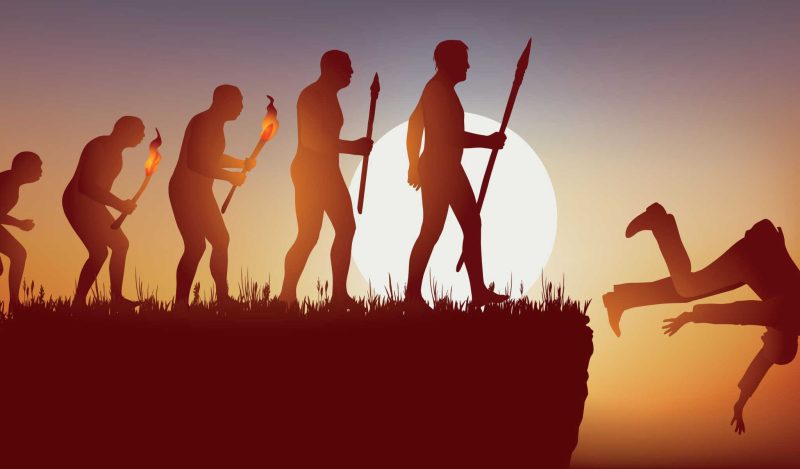A new genre in philosophy made its appearance not too long ago. It is called ‘extinction theory’ or the ‘philosophy of extinction,’ and as the name indicates, it is predicated on the real possibility that the human species may cause the extinction of what it means to be human and that it may actually become extinct as a species. On p. 9 of Death of the Posthuman – Essays on Extinction (Vol. 1, Open Humanities Press, 2014), Claire Colebrook writes:
There are three senses of extinction: the now widely discussed sixth great extinction event (which we have begun to imagine and witness, even if in anticipation); extinction by humans of other species (with the endangered species of the ‘red list’ evidencing our destructive power); and self-extinction, or the capacity for us to destroy what makes us human.
It would take a book-length study to elaborate on all the things that make us human, but for now Colebrook’s observation (p. 12) should give us some valuable clues:
Precisely at the moment of its own loss the human animal becomes aware of what makes it human—meaning, empathy, art, morality—but can only recognize those capacities that distinguish humanity at the moment that they are threatened with extinction.
Colebrook’s book appeared before the advent of COVID-19, so one may surmise that she would find in the imposition of ‘inhuman’ restrictions such as ‘lockdowns,’ ‘social distancing,’ ‘masking,’ and particularly ‘vaccine’ mandates ample corroboration for her argument about the extinction of those qualities that are distinctively human.
In her book, The Bodies of Others (All Seasons Press, 2022), Naomi Wolf gave an incisive interpretation of the insidious manner in which all these restrictions have targeted our very humanity by severely limiting the constitutively human things we usually do, such as embracing or touching one another affectionately, or gathering in diverse cultural spaces for celebration, entertainment or religious worship.
Confirming Wolf’s insight I recall that, in one of his video addresses, international lawyer and well-known leader of the International Criminal Investigative Committee, Dr Reiner Fuellmich, tells the story – that actually happened – of an elderly woman, who entreats a man who is standing near her in a public space not to come any nearer because of her fear of being infected with the dreaded coronavirus. Instead of withdrawing, the man steps forward and hugs the old lady, enfolding her in his arms. In her turn, she does not push him away, but confesses to him (unsurprisingly) that this was what she missed most.
All these things give credence to Colebrook’s contention, that we are witnessing the extinction of what makes us human. In his essay, “Mass formation and the psychology of totalitarianism” (in Robert W. Malone’s Lies my Gov’t Told Me – And the Better Future Coming; Skyhorse Publishing, 2022), Matthias Desmet sums up what happened during COVID as follows (p. 100):
The COVID crisis did not come out of the blue. It fits into a series of increasingly desperate and self-destructive societal responses to objects of fear: terrorists, global warming, coronavirus. Whenever a new object of fear arises in society, there is only one response: increased control. Meanwhile, human beings can only tolerate a certain amount of control. Coercive control leads to fear, and fear leads to more coercive control. In this way, society falls victim to a vicious cycle that leads inevitably to totalitarianism (i.e., extreme government control) and ends in the radical destruction of both the psychological and physical integrity of human beings.
What such “radical destruction” amounts to has been witnessed by many of us in the course of more than three years – at least by those (a relatively small percentage of people) who have not been negatively affected by what Desmet calls “mass formation,” which he characterises as follows (p. 98): “What is mass formation actually? It’s a specific kind of group formation that makes people radically blind to everything that goes against what the group believes in.”
In this way, they take the most absurd beliefs for granted.” Desmet (p. 100) goes on to endorse Hannah Arendt’s insight (in 1951 already), that “a new totalitarianism is emerging in our society. Not a communist or fascist totalitarianism, but a technocratic totalitarianism.” Not only does this testify to the acuity of the German-American philosopher’s intuition, but it brings into sharper focus the degree to which such “technocratic totalitarianism” has become virtually pervasive today, exacerbating the ‘extinction’ of our humanness in an unprecedented way. But Desmet has more uplifting things to say, too (p. 100):
As always, a certain part of the population will resist and won’t fall prey to the mass formation. If this part of the population makes the right choices, it will ultimately be victorious. If it makes the wrong choices, it will perish. To see what the right choices are, we have to start from a profound and accurate analysis of the nature of the phenomenon of mass formation. If we do so, we will clearly see what the right choices are, both at strategic and at the ethical levels.
Desmet’s own substantial contribution to such an analysis of ‘mass formation’ in his book, The Psychology of Totalitarianism (2022), is probably known to many readers, but every new publication by writers who focus on aspects of the continuing attempt to catch societies all over the world in a totalitarian web, contribute further to the much-needed comprehension of this lamentable phenomenon, which has been instrumental in reducing human beings to a state where their distinctive human qualities are severely eroded.
So far I have concentrated on ‘extinction’ in Colebrook’s sense of those things that ‘make us human,’ but a more literal meaning of the word is also applicable here; radically formulated, that humankind is on the brink of extinction. One manifestation of such a possibility lies in the (by now familiar, and to my mind unjustifiable) practice of ‘gain-of-function’ bio-technical research.
The usual way in which such research is justified is to claim that, by modifying naturally occurring pathogens in laboratories, one can prepare for such naturally occurring ‘modifications’ or mutations by developing ‘vaccines’ in anticipation of such an eventuality. That such a justification is spurious, becomes abundantly obvious in light of the laboratory-development, by Bill & Melinda Gates Foundation-funded research, of a lethal virus that is a combination of the avian and swine influenza viruses, respectively.
And as if this were not already in the realm of absurd risk, the research team, led by Dr Yoshihiro Kawaoka, spliced something else into the hybrid virus, namely a part of a human gene which would bypass the human immune system and give it direct access to the organism’s most vulnerable parts. In a video on this (7 minutes, 28 seconds into video), the ‘Ice Age Farmer’ discusses this gain-of-(lethal)-function research of Dr Kawaoka, who previously said that a “hybrid swine-bird flu virus [is] possible,” and would be “extremely lethal.”
In the video on Kawaoka’s research it is further disclosed, supported by documentary evidence from a press release by the University of Wisconsin-Madison (Ice Age Farmer 2022: 7 min. 43 sec. into video), that Kawaoka’s work has resulted in something extremely pathogenic. The press release states that (Ice Age Farmer video; 7 min. 50 sec. into video):
What is so interesting about Dr Kawaoka’s recent experiments is that he targeted PB2, the segment which few know enough about to be decisive. Dr Kawaoka and his research team have taken a human PB2 gene segment and spliced it to H5N1 bird flu. The result is a more lethal and even more virulent virus than the parent H5N1 strain.
Dr Kawaoka and his staff have now, and pretty conclusively, named PB2 as the gene segment responsible for lethality in humans.
The Ice Age Farmer (2022: 8 min. 30 sec. into video) informs one further that Dr Kawaoka’s research has (understandably) caused controversy in the community of scientists, who have, to their credit, “…expressed horror for the creation of this virus that would render the human immune system defenceless.”
Regardless of how scientists like Kawaoka, and gain-of-function ‘entrepreneurs’ like Bill Gates, may try to defend such research by arguing that it enables scientists to anticipate and prepare for possible pandemics – probably caused by these laboratory-created viruses – this is demonstrably disingenuous, and conspicuously amounts to mere gaslighting. What are the chances that a natural introduction of the PB2 gene segment into the hybrid bird flu/swine flu virus would occur? Pretty insignificant. However, it bears no emphasis to realise that, with this kind of ‘research’ going on in various biotechnical laboratories, the extinction of the human race is certainly within the realm of possibility.
Furthermore, one need not even allude to biogenetic research of the kind discussed above. According to Karen Kingston, bio-tech analyst and whistleblower, the research that produced the COVID-19 ‘vaccines’ already put humanity on the path to extinction.
Although the thought of human extinction in this literal sense may seem far-fetched to some, the evidence that Kingston has produced is reason for concern. This includes not only the lethality of the mRNA ‘vaccines,’ but also of so-called “directed evolution” through mRNA technology – which “is forcing the evolution of humans to merge with DNA from reptiles, insects and artificial intelligence…It is about merging the biodigital with humans” (quoted by Hunter in the article referred to). One has to be blind not to see that this has the death of the human species as we know it writ large all over it.
Join the conversation:


Published under a Creative Commons Attribution 4.0 International License
For reprints, please set the canonical link back to the original Brownstone Institute Article and Author.









